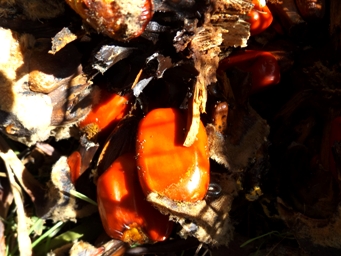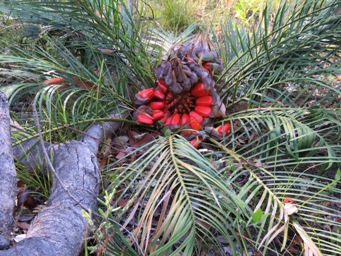Australia So Much to See
Male and female flowers, fruit filled with initially bright orange seeds like small eggs. The vibrant colour fades.
Plant toxic to cattle. Various parts of the seeds of Macrozamia species were eaten by Aborgines after treatment, which varied between regions of being by water or be burial.
Macrozamia spp. (Burrawangs)
The seeds of these and other cycads are borne in a large cone and have an orange outer coat. They are
POISONOUS, but the Aborigines knew how to treat them to remove the poison, and so take advantage of the large amount of food provided
by a single plant. One of the ways was to cook the seed, break it up, and then soak it for up to three weeks in running water.
In
Western Australia, only the outer red part was eaten, after treatment by washing and burying.
NSW, NT, QLD, WA.
Extract from Australian National Botanic Gardens
Burrawong is from an Aboriginal language in New South Wales
Macrozamia riedlei
Another food which required considerable preparation before it could be eaten was the fruit of the Zamia palm (Macrozamia riedlei)
which, being one of the few trees in the area which bore edible fruit (see below), was an important source of food. The " Zamia nuts
", known as baio, bayio, boyoo, or byyu (see Appendix 3), caused vomiting if they were eaten raw, and were considered poisonous by
the Aborigines (Grey 1841, vol. 2, p. 295; Drummond 1839a MS.).
Towards the end of March, when the fruit was ripe, it was collected,
soaked in water for a period, and then buried until the pulp was then safe to be eaten either raw or roasted (Backhouse 1843, p. 541;
Grey 1841, vol. 2, p. 296; Hammond 1933, p. 28; Moore 1884b, p. 17; Stokes 1846, vol. 2, p. 132).
Extract from Museum of Western Australia
Macrozamia
riedlei, Aboriginal name: Jeeriji (Noongar)
The toxic seeds were used as a food by Aboriginals after extensive processing, European
explorers were poisoned from eating them raw.
• After treatment, the pulp which encases the seed is roasted
before eating, it tastes similar to a tomato
• Raw seeds were ground into a powder and used to ‘stun’ fish in
local waterways to make the fish easier to catch
Extract from SERCUL
Noongar people ate only
the seed covering
The traditional Noongar people of south-western Australia developed over many thousands of years an effective means
of detoxifying and enhancing the nutrient food value of the bright red outer seedcoat of the toxic Macrozamia plant through a process
of soaking and burying the seed in an anaerobic environment for several weeks. It would seem that the toxin (macrozamin) diminishes
and is potentially eliminated as a result of this unique controlled fermentation and storage process - the end product being an extremely
nutritious and favoured food known as by-yu (or kwineen) rich in oil and carotene.
Extract from Anthropology from the shed
From
multiple sources, as referenced in the link
Seeds of the zamia, a spiky, palmlike plant, were dried in the sun, then put in a dilly
bag and suspended in running water for 4-5 days. They were then crushed and pounded between two flat stones and ground into a fine
paste. This paste was wrapped in paper bark, baked under ashes and eaten as cakes.
Seeds of the pineapple palm were crushed
into a flour, then washed in running water for a week, cooked in hot coals and eaten.
Extract from The Western A Price Foundation
Aboriginal
Culture within Mooro Country, Nyoongar people who lived between Fremantle and
Moore River
The Zamia Palm (Djiridji) is a cycad which
grows locally. They have large seed pods full of red seeds (bayou) which were collected, however the seeds were not eaten straight
away due to toxins in the plant. To leach the poison out of the seeds a reed bag was made. The kernels from the seeds were placed
in these reed bags and put under running water for three to four weeks. Once the toxins were gone the kernels were ground into a paste
like dough and cooked under the hot ashes of the fire. A small grove of zamia palms still exists on the western shore of Lake Joondalup.
Extract from City of Joondalup; link is no longer available.
Macrozamia fraseri and Macrozamia riedlei both as toxic
Ockham's
razor explores the differences.

